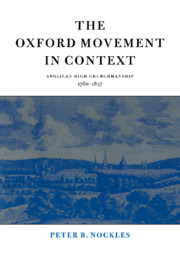Book contents
- Frontmatter
- Contents
- Preface
- List of abbreviations
- Historiographical introduction
- 1 Church and state: the politics of High Churchmanship
- 2 Antiquity and the rule of faith
- 3 Ecclesiology: the apostolic paradigm
- 4 Spirituality, liturgy and worship
- 5 The economy of salvation: sacraments and Justification
- 6 The old High Churchmen and Tractarians in historical relation
- Conclusion
- Select bibliography
- Index
6 - The old High Churchmen and Tractarians in historical relation
Published online by Cambridge University Press: 23 September 2009
- Frontmatter
- Contents
- Preface
- List of abbreviations
- Historiographical introduction
- 1 Church and state: the politics of High Churchmanship
- 2 Antiquity and the rule of faith
- 3 Ecclesiology: the apostolic paradigm
- 4 Spirituality, liturgy and worship
- 5 The economy of salvation: sacraments and Justification
- 6 The old High Churchmen and Tractarians in historical relation
- Conclusion
- Select bibliography
- Index
Summary
TRACTARIANISM IN CONTEXT: HISTORICAL BACKGROUND, 1760–1833
From the 1710s until 1760, High Churchmen were marginalised from the inner counsels of church and state. There were, however, High Church Whigs such as Bishop Gibson, Archbishop Wake and Archbishop Potter. As Mather shows, the preferment of High Churchmen to the bench such as Thomas Sherlock, Thomas Gooch and Henry Stebbing helped ensure the survival of High Church values within the establishment into the second half of the century. If Latitudinarians were dominant among the mid-century episcopate, they had no absolute monopoly. The fact that there were many other sources of patronage apart from that of the crown, such as Oxford colleges, meant that avenues to higher preferment were not closed to High Churchmen. High Church resistance to Hoadlyism remained alive even during the nadir of High Church fortunes in the 1740s and 1750s. The accession of George III in 1760 opened a new era. The tide of ministerial preferment turned in favour of High Churchmen. Although Jones of Nayland obtained no high recognition, various Hutchinsonian divines such as Nathaniel Wetherell, George Berkeley junior, George Home and Samuel Glasse, all obtained deaneries or royal chaplaincies from the late 1760s onwards. By the late 1790s, the prevailing character of the episcopate was Orthodox, with John Warren, Charles Moss, Samuel Horsley and the Hutchinsonian, John Douglas, Bishop of Salisbury, being particularly High Church.
- Type
- Chapter
- Information
- The Oxford Movement in ContextAnglican High Churchmanship, 1760–1857, pp. 270 - 306Publisher: Cambridge University PressPrint publication year: 1994



